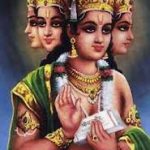Brahma rose to importance in the late Vedic period of the Aranyakas and Upanishads, after the first Hindu triad declined—that of Surya, Indra, and Agni. Brahma’s temple at Pushkara was the beginning point for pilgrimages from the time of the two great epics. However, it turned out to be the only temple dedicated to Brahma as the primary deity that has survived the centuries. His cult may have once been important enough to command the respect of pilgrims, but he was badly used in most of the later myths. Even though Brahma has had roles in more myths than any other god or goddess, his parts have left him flat and one-dimensional.
In the Brahmanas he was associated with Prajapati and later replaced him as the creator. His creations, however, came to be seen as re-creations. It was (Siva, Vishnu, or Devi who was said to be the ultimate origin of the universe. Brahma was only its current creator (or re-creator).
In his many myths Brahma rewarded austerities (tapas) of men and demons by granting them their most frequent wish, the wish for immortality. Although that boon was limited and did not bestow complete immortality, it always caused a great deal of trouble for the gods. So Brahma was usually in trouble with the other gods. In these instances, Vishnu or Siva, depending on the viewpoint of the myth, would save the gods from the demons. The supreme god, Vishnu or (Siva, would find the limitation of Brahma’s boon of immortality in order to defeat the demon who had gained the boon and return the world to its proper order.
In the Puranas, Brahma the creator was joined in a divine triad with Vishnu and Mahesvara ((Siva), who were the preserver and destroyer, respectively. The universe was created by Brahma, preserved by Vishnu, and destroyed for the next creation by SSiva. However, the birth of Brahma was attributed to Vishnu in some myths. Brahma was often depicted as sitting on a throne arising from the navel of Vishnu, who was resting on the cosmic serpent, Ananta (also Sesha). In the very beginning Vishnu alone was there. When Vishnu thought about creation, Brahma was created from a lotus that came from his navel.
There was a Saiva myth that told of (Siva’s appearance to Vishnu and Brahma as a cosmic linga. Vishnu attempted to go to the top and bottom of this giant pillar. He was only able to go to the top of the universe and the bottom of the sea, but he did not find the end of the linga. Brahma lied that he had reached its end, thus claiming to be superior to SSiva. So SSiva cursed him, so that Brahma would never again have temples dedicated to his worship, and except for the temple to him at Pushkara, the myth seemed to fit the facts of history so that the curse seems to have been fulfilled.
The four-headed Brahma is the creator in the Trimurti or Hindu Triad, which also includes Siva and Vishnu. (TRIP)
His final roles in the later Puranas were reminders of how mighty Brahma was debased. One myth claimed that Brahma committed incest with his daughter, goddess of speech (Vac). But this myth had already been told about Prajapati, lord of creatures.
Iconographically, Brahma’s image had four heads. (A fifth had been cut off by the fingernail of a horrific aspect of Siva.) He carried a water jar, offering ladle, meditation beads, a lotus, and a bow or scepter. His vehicle was the swan (hamsa) or goose.

